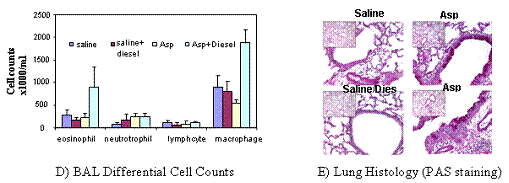Grantee Research Project Results
2006 Progress Report: Mechanistic Research Project
EPA Grant Number: R832141C003Subproject: this is subproject number 003 , established and managed by the Center Director under grant R832141
(EPA does not fund or establish subprojects; EPA awards and manages the overall grant for this center).
Center: Columbia Center for Children’s Environmental Health
Center Director: Perera, Frederica P.
Title: Mechanistic Research Project
Investigators: Rothman, Paul B.
Current Investigators: Rothman, Paul B. , Chen, Lung Chi , Miller, Rachel L. , Grunig, Gabriele
Institution: Columbia University in the City of New York
Current Institution: Columbia University in the City of New York , New York University
EPA Project Officer: Callan, Richard
Project Period: November 1, 2003 through October 31, 2008 (Extended to October 31, 2010)
Project Period Covered by this Report: November 1, 2005 through October 31,2006
RFA: Centers for Children's Environmental Health and Disease Prevention Research (2003) RFA Text | Recipients Lists
Research Category: Children's Health , Human Health
Objective:
The specific aims of the project are to use mouse models to determine whether: (1) in utero sensitization increases the risk for subsequent airway hyperreactivity and antigen-induced inflammation; (2) diesel exhaust particles (DEP), endemic to the Northern Manhattan environment, promote antigen-specific prenatal sensitization, and whether this occurs by upregulating Th2-mediated allergic responses, and whether polycyclic aromatic hydrocarbons (PAHs), measured by PAH-adducts in lung tissue, mediates this response; and (3) endotoxin protects from the development of antigen-specific prenatal sensitization, and whether this occurs by upregulating Th1-mediated immune processes.
Progress Summary:
Development of Mouse Model for In Utero Sensitization to Ovalbumin
Our data support the hypothesis that sensitization in utero to ovalbumin (OVA) occurs. We found (Figure 1) that offspring of mice sensitized and challenged with OVA exhibited increased airway hyperresponsiveness (AHR) (A), increased allergic pulmonary inflammation (B), and increased levels of OVA-specific IgE (C) compared to offspring of non-treated mice. These data, in support of Aim 1, suggest that a pregnant mouse sensitized to OVA can transfer an asthma-like phenotype to her offspring.
Figure 1. Mouse Model for In Utero Sensitization to Ovalbumin
Development of Mouse Model for In Utero Sensitization to Mold Aspergillus (Asp Ag)
Female mice were exposed to the aerosolized aspergillus (Aspergillus fumigaus protein extract) prior to mating and during pregnancy and their offspring were examined for aspergillus-induced AHR and airway inflammation. Preliminary data suggest that offspring born to mothers exposed prenatally to aspergillus (dose 12.5 or dose 25) developed increased AHR and inflammatory cells in their bronchoalveolar fluid compared to naïve mice. These results suggest that in utero sensitization to environmental inhaled allergens may occur in our mouse model.
Effects of Prenatal Diesel (DEP) Exposure in Combination With Mold Aspergillus Fumigatus (Asp Ag) on Asthma-Like Outcomes in Mice
Our preliminary experiments (Figure 2) indicate that pups from the mothers sensitized with Asp Ag and exposed to DEP during their pregnancy have more eosinopils in their broncho-alveolar lavage (BAL) (D), and goblet cell hyperplasia observed from lung histology (E) than the other three control groups. These findings suggest that prenatal DEP exposure, concomitant with antigen exposure, may increase the risk of allergic airway inflammation in the second generation offspring.
Figure 2. Effects of DEP and Asp Ag on Asthma-Like Outcomes in Mice
Significance
These results corroborate that in utero sensitization to ovalbumin, and possibly the inhaled mold aspergillus, occurs in reliable mouse models. Prenatal exposure to diesel may modulate these effects.
Future Activities:
Plans are multifold and include to: (1) analyze cockroach sensitization protocols (already initiated); (2) repeat and confirm the aspergillus model and stringently compare immunological outcomes with the OVA model; and (3) determine whether endotoxin protects against the development of antigen-specific prenatal sensitization. We also plan to test our models in several knockout mice (e.g., Stat6) to help determine the mechanism for in utero sensitization to antigens in a manner that would not be feasible in human subjects.
Supplemental Keywords:
children’s health, genetics, health effects, health risk assessment, assessment of exposure, endotoxins, PAHs, OVA, environmental risks, environmental exposure, exposure assessment, genetic risk factors, genetic susceptibility, maternal exposure, nutritional risk factors, diesel exhaust,, Health, RFA, Scientific Discipline, Air, INTERNATIONAL COOPERATION, ENVIRONMENTAL MANAGEMENT, Health Risk Assessment, Environmental Policy, Children's Health, Biochemistry, air toxics, Genetics, Risk Assessment, genetic mechanisms, health effects, Human Health Risk Assessment, diesel exhaust, maternal exposure, environmental risks, genetic risk factors, genetic susceptibility, diesel exhaust particulate, nutritional risk factors, assessment of exposure, PAH, children's environmental healthRelevant Websites:
http://www.mailman.hs.columbia.edu/ccceh/ Exit
Progress and Final Reports:
Original AbstractMain Center Abstract and Reports:
R832141 Columbia Center for Children’s Environmental Health Subprojects under this Center: (EPA does not fund or establish subprojects; EPA awards and manages the overall grant for this center).
R832141C001 Growth and Development Research Project: Prenatal and Postnatal Urban Pollutants and Neurobehavioral Developmental Outcomes
R832141C002 Research Project on Asthma: Prenatal and Postnatal Urban Pollutants and Childhood Asthma
R832141C003 Mechanistic Research Project
R832141C004 Community-Based Intervention Project: Reduction of Exposure and Risk from Pesticides and Allergens
R832141C005 Community Translation and Application Core (COTAC)
R832141C006 Exposure Assessment Facility Core
R832141C007 Data Management, Statistics and Community Impact Modeling Core
R832141C008 Administrative Core
The perspectives, information and conclusions conveyed in research project abstracts, progress reports, final reports, journal abstracts and journal publications convey the viewpoints of the principal investigator and may not represent the views and policies of ORD and EPA. Conclusions drawn by the principal investigators have not been reviewed by the Agency.


